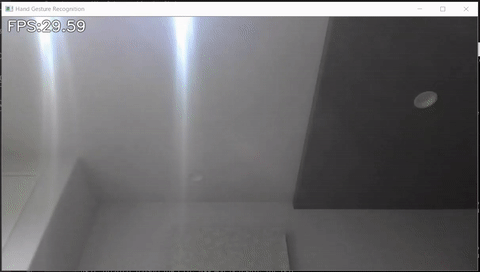This is a sample code program that builds functionalities (virtual keyboard, touchpad, and drawboard) upon hand gesture recognition project (this one) which utilizes a simple MLP using key points detected with Mediapipe.
This repository contains the following contents.
- Sample program
- Hand sign recognition model(TFLite)
- Hand controlled virtual touchpad
- Hand controlled virtual keyboard
- Hand controlled virtual drawboard
* mediapipe 0.8.1
* OpenCV 3.4.2 or Later
* Tensorflow 2.3.0 or Later<br>tf-nightly 2.5.0.dev or later (Only when creating a TFLite for an LSTM model)
- scikit-learn 0.23.2 or Later (Only if you want to display the confusion matrix)
- matplotlib 3.3.2 or Later (Only if you want to display the confusion matrix)
- pyautogui 0.9.54 or Later
Here's how to run the demo using your webcam.
python app.pyThe following options can be specified when running the demo.
- --device
Specifying the camera device number (Default:0) - --width
Width at the time of camera capture (Default:960) - --height
Height at the time of camera capture (Default:540) - --use_static_image_mode
Whether to use static_image_mode option for MediaPipe inference (Default:Unspecified) - --min_detection_confidence
Detection confidence threshold (Default:0.5) - --min_tracking_confidence
Tracking confidence threshold (Default:0.5) - --function to be enabled
- --max_num of hands detected
│ app.py
│ keypoint_classification.ipynb
│ point_history_classification.ipynb
│
├─model
│ ├─keypoint_classifier
│ │ │ keypoint.csv
│ │ │ keypoint_classifier.hdf5
│ │ │ keypoint_classifier.py
│ │ │ keypoint_classifier.tflite
│ │ └─ keypoint_classifier_label.csv
│ │
│ └─point_history_classifier
│ │ point_history.csv
│ │ point_history_classifier.hdf5
│ │ point_history_classifier.py
│ │ point_history_classifier.tflite
│ └─ point_history_classifier_label.csv
├─plugin
│ ├─cnn_model
│ │ │ dataCNN
│ │ │ cnn_labels.json
│ │ │ cnn.py
│ │ │ getdata.py
│ │ │ load_model.py
│ │ └─ make_labels.py
│ │
│ │ blackboard.py
│ │ keyboard.py
│ │ mouse.py
│ │ stablediffusion.py
│ │ UI.py
│ └─point_history_classifier
│
│
└─utils
└─cvfpscalc.py
This is a sample program for inference.
In addition, learning data (key points) for hand sign recognition,
You can also collect training data (index finger coordinate history) for finger gesture recognition.
This is a model training script for hand sign recognition.
This is a model training script for finger gesture recognition.
This directory stores files related to hand sign recognition.
The following files are stored.
- Training data(keypoint.csv)
- Trained model(keypoint_classifier.tflite)
- Label data(keypoint_classifier_label.csv)
- Inference module(keypoint_classifier.py)
This directory stores files related to finger gesture recognition.
The following files are stored.
- Training data(point_history.csv)
- Trained model(point_history_classifier.tflite)
- Label data(point_history_classifier_label.csv)
- Inference module(point_history_classifier.py)
This is directory stores the different functions as plugins that will be inserted in app.py.
The following folders/files are stored.
- cnn_model
- blackboard.py
- keyboard.py
- mouse.py
- stablediffusion.py
- UI.py
This is a module for FPS measurement.
Hand sign recognition and finger gesture recognition can add and change training data and retrain the model.
Press "k" to enter the mode to save key points(displayed as 「MODE:Logging Key Point」)

If you press "0" to "9", the key points will be added to "model/keypoint_classifier/keypoint.csv" as shown below.
1st column: Pressed number (used as class ID), 2nd and subsequent columns: Key point coordinates

The key point coordinates are the ones that have undergone the following preprocessing up to ④.


In the initial state, three types of learning data are included: open hand (class ID: 0), close hand (class ID: 1), and pointing (class ID: 2).
If necessary, add 3 or later, or delete the existing data of csv to prepare the training data.



Open "keypoint_classification.ipynb" in Jupyter Notebook and execute from top to bottom.
To change the number of training data classes, change the value of "NUM_CLASSES = 3"
and modify the label of "model/keypoint_classifier/keypoint_classifier_label.csv" as appropriate.
The image of the model prepared in "keypoint_classification.ipynb" is as follows.

Press "h" to enter the mode to save the history of fingertip coordinates (displayed as "MODE:Logging Point History").

If you press "0" to "9", the key points will be added to "model/point_history_classifier/point_history.csv" as shown below.
1st column: Pressed number (used as class ID), 2nd and subsequent columns: Coordinate history

The key point coordinates are the ones that have undergone the following preprocessing up to ④.

In the initial state, 4 types of learning data are included: stationary (class ID: 0), clockwise (class ID: 1), counterclockwise (class ID: 2), and moving (class ID: 4).
If necessary, add 5 or later, or delete the existing data of csv to prepare the training data.




Open "point_history_classification.ipynb" in Jupyter Notebook and execute from top to bottom.
To change the number of training data classes, change the value of "NUM_CLASSES = 4" and
modify the label of "model/point_history_classifier/point_history_classifier_label.csv" as appropriate.
The image of the model prepared in "point_history_classification.ipynb" is as follows.

The model using "LSTM" is as follows.
Please change "use_lstm = False" to "True" when using (tf-nightly required (as of 2020/12/16))

Kazuhito Takahashi(https://twitter.com/KzhtTkhs)
Nikita Kiselov(https://github.com/kinivi)
hand-gesture-recognition-using-mediapipe is under Apache v2 license.

